Site Menu:
| This is an archived Horseadvice.com Discussion. The parent article and menus are available on the navigation menu below: |
| HorseAdvice.com » Diseases of Horses » Skin Diseases, Wounds, and Swellings » Wounds / Burns » Wounds: First Aid Care » |
| Discussion on Serious injury to front of hock in dressage horse - help! | |
| Author | Message |
| Member: cathyb1 |
Posted on Friday, Apr 18, 2008 - 6:37 am: Dr O, I have read all that I can find on your website about hock injuries, proud flesh etc etc. But I am still wracked with indecision and concern.I have a beautiful warmblood mare, 9yo. She is a striking mare, big, big moving, and I have been competing her at Medium level, and training Advanced. She is very talented, and very valuable, but most of all, she is very important to me; as well as being my favourite horse, she has taught me many lessons, both about training horses, but also about myself. For this, I owe this horse a great deal. I bought her as a yearling; broke her in, trained her myself all the way. I have always (like so many other riders) hoped that, one day, this mare and I would compete at the top level in this country. She, however, unconscious of my ambition, has taught me that to progress towards one’s ambition, one has to forget it, and work patiently on the same things, until she decides it is time to move on. For someone whose motto has always been, “make it happen”, I have had to learn to “let it happen”. This has been a good lesson, which I have applied to my whole life and my relationships with friends, children, family. So, imagine my distress, when my husband and I were on a well deserved break, to receive a message from the young man working for us on our farm that my mare was injured. We came home the next day. Apparently, she had been talking to my young gelding over the electric fence, which, ( it later turned out) was not working at the time. She must have turned, kicked out, and caught her hind leg over one of the wires. The young fellow, discovering her at 3pm on 20th March 2008, called the local vet, who came out, cleaned the injury, bandaged her, gave her penicillin and left her in the paddock. We arrived home the next morning, and immediately unwrapped the bandage, assessed the damage – severe laceration to the front of the hock joint, bang on the front of the joint. The injury was about 5 inches long, 4 inches wide, travelling on an angle across the hock joint, with a large roll of skin, all bunched up like a sausage, at the bottom of the injury. We took her over to the Equine Hospital. At this stage, she wasn’t lame. I left her at the hospital, where they operated on her, pulling the edges of the wound together, and doing a very neat job. The vets there ( amongst the best in the field of equine vets) had inspected the tendons and joint, and thought that all was intact. I brought her home on the 22nd March, and put her in the stable, with antibiotics twice a day (penicillin and neomycin, I think), and changing the dressing every day. I was relieved, and thought all would be fine, just a bit of a scar. On the 24th March, my mare was lame. She was definitely avoiding weight on the hind leg. I thought perhaps I had bandaged too tight. I changed the bandage, but by 2pm, she was dead lame – wouldn’t put the foot to the ground. So back to hospital. As it was a public holiday, one of the senior partners attended on my mare. He xrayed the joint, ultra sounded it, and pronounced an infected tendon sheath. He cut open the sutures, exposing the extensor tendon, and flushed it with antibiotics and saline. I was in shock as he explained that her days as a dressage horse were over; IF she survived, she might make a brood mare. She remained in hospital for the next 5 days, receiving massive doses of antibiotics, with the tendon sheath draining freely. By the 26th , she was sound, putting the foot to the ground. On the 28th, I brought her home to stall rest, changing the bandage daily. You could see the tendon sheath; the wound was absolutely horrible. Over this time, the injury ( which was about 5 inches wide by 4 inches high )started to granulate. Every couple of days, I emailed photos of the wound to the vet. The mare was allowed into a yard on 14thApril, and on 16th April, the vet recommended removing the bandage. This was hard to do, and even harder when, the following morning, it appeared that the wound had gone mad in the night, with proud flesh bulging out of the wound by half an inch. I rang the vet, (and sent him more photos – he must think I’m stalking him!), and he assured me that the best thing was for the proud flesh to grow out, cover up the tendon sheath (which has been the slowest area to granulate over, due to the movement). Then next week, when the proud flesh is growing out and everything is covered up by proud flesh, I will take her over to the hospital, and he will slice it all off. Now, I have done my reading, and this all makes sense. However, I have to look at this leg; all I can see is my beautiful horse with a ruined leg. The vet ( who I have a lot of faith in), is 97% sure that she will return to full work. But it seems wrong to leave this injury, without cleaning it ( beyond hosing off any wood shavings that have stuck to it), without dressing it ( he wants proud flesh to grow). She walks around her yard during the day, which I understand is good for the tendon, and for the prevention of adhesions, and will promote the formation of proud flesh. She moves a bit stiffly on the leg. I suppose what I want is corroboration that I am following the correct course of action – it just seems WRONG to leave such a hideous injury open. I feel like the most neglectful horse owner in the world. This is a horse that normally wears shin boots in the paddock to avoid injury, and is rugged and cared for better than my children! Am I following the right track? Is there ANYTHING I could put on this injury to help? Or is it just time? Is there anyone out there who has had this experience, and it all turned out all right? If so, please let me know. I will try to upload some of the photos, so that (hopefully) lots of people will write back and say, “Oh, sure, my horse had MUCH worse and now he is an Olympic showjumper etc etc”. Sorry to sound so neurotic, but I am at the moment! |
| Member: cathyb1 |
Posted on Friday, Apr 18, 2008 - 8:26 am: Here are some photos of the injury I described. Hope this works! First photo is 5 days after the infected tendon sheath was treated.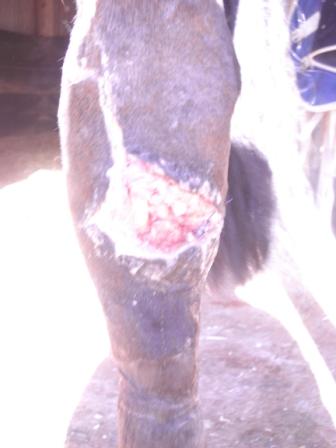 Next photo is Honey's leg when I removed the bandage. 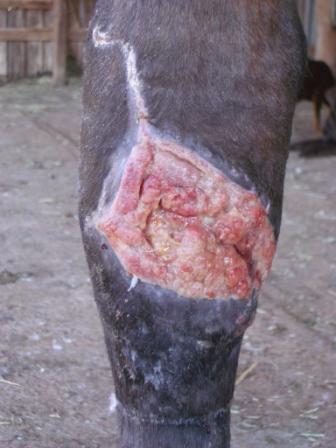 Last photo is the morning after I removed the bandage. 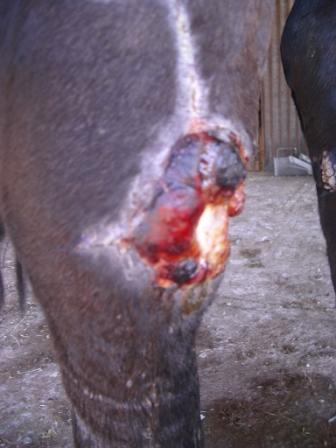 The creamy coloured part to the left of the photo is where there is a gap in the granulation tissue, going straight to the tendon sheath. There is creamy pus oozing from this gap continuously still, but the horse is not lame, just a bit stiff in the hock as she walks around. Do these look right to you? What would you suggest from here, Dr. O? |
| Member: mysi |
Posted on Friday, Apr 18, 2008 - 10:17 am: Cathy,My horse had a simular looking injury to both of his knees, not as big (3"x3"), but open to the bone. It looked like your first 2 pictures through the healing process. I was told to (and did) keep him bandaged for about 12 weeks (maybe more). I had to de-bandage, clean and re-bandage daily the first 4 weeks and then every other day after that. I had to keep him bandaged until the skin looked like skin again. (no more granulation, etc.) The first 4-6 weeks I had him in full leg bandages to keep the mobility down, could only hand walk. I have to say, the progress was amazing everyday. I used a good antibiotic cream (it was like $100 for the jar) over the wound and put a absorbent sponge pad over that, then wrapped around a roll of 3" stretch gauze over that, then wrapped a roll of cotton around the knee, followed with vet wrap, and elastikon on each end of that to seal off the bandaging so nothing could get inside, followed with a standing wrap on the bottom. Quite a process daily, but I became a pro, and the vet said I did a better job than her. Then he graduated and no more standing wrap, cotton roll or vet wrap. I never had to have the proud flesh cut off. The vet gave me these little sticks that burned it off (no pain to the horse). I used them every few days. I also used scarlet oil. I wish I would have taken picture through the process to post here but honestly the thought never crossed my mind. My vet wished she did too because of the incredible injury and recovery. However I do have pics of the bandaging, go figure. Here's pics oh how he was bandaged the first 4-6 weeks 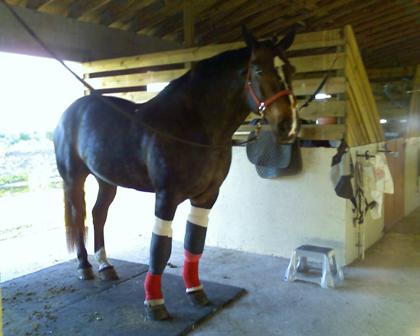 and then for the remainder. 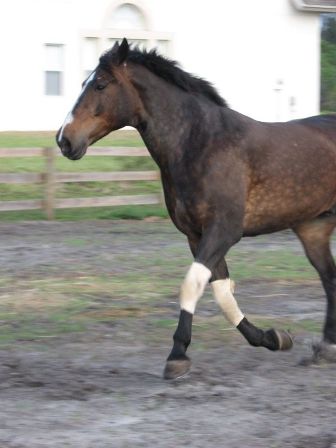 I am not sure why your vet wants you to keep your horse open, but I am sure there is a reason. Dr. O will have alot of helpful info. |
| Moderator: DrO |
Posted on Friday, Apr 18, 2008 - 11:01 am: Hello All,In short yes the plan for dealing with the proud flesh is reasonable. I like the appearance of the wound in the second photo in that it is a clean healthy granulation bed that has not become exuberant. But the most important photo is left out: what does the hock look like now? I would hose a wound that looks like that daily but a little more aggressively than you suggest you are doing (see Long Time Wound Care for details). I think it does slow down proud flesh formation but does not prevent a good granulation bed from forming. Once a wound is well granulated in, topicals and bandaging become a debatable subject. I tend to continue with topicals but may stop bandaging at that point but it does depend on the details of the situation. DrO |
| Member: cathyb1 |
Posted on Tuesday, Apr 22, 2008 - 2:54 am: How aggressively should I hose it?Here is a photo of my mare's leg today. 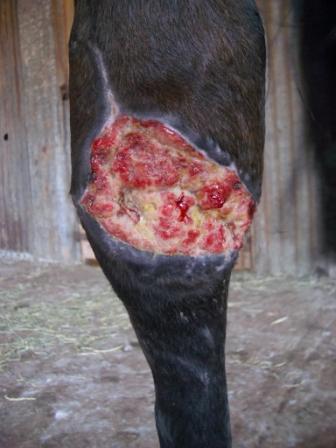 It is 33 days since she originally injured it. I have been hosing it daily, cleaning away the dried exudate etc. The bulging parts of the wound seem to have reduced, and are almost flat with the skin; the hole over the tendon has filled in so that I can't see the tendon anymore (phew!). I have only been putting on an antibacterial cream that has an anti insect component, as the flies are bad here, but I basically just put a smear of it over the bulgiest parts of the injury, keeping it off the parts that still need to fill in, as I am not sure of the cream's effect on the production of granulation tissue. It is 33 days since she originally injured it. I have been hosing it daily, cleaning away the dried exudate etc. The bulging parts of the wound seem to have reduced, and are almost flat with the skin; the hole over the tendon has filled in so that I can't see the tendon anymore (phew!). I have only been putting on an antibacterial cream that has an anti insect component, as the flies are bad here, but I basically just put a smear of it over the bulgiest parts of the injury, keeping it off the parts that still need to fill in, as I am not sure of the cream's effect on the production of granulation tissue. You can see that there is swelling around the injury; the vets believe the joint is OK, so will this swelling go away? The mare can walk around her yard fine, but is noticeably lame when she trotted across her yard today. It was the first time I have seen her trot, and I was disappointed to see her lame. Is this just because of the wound, or is it something more sinister? Should I be concerned? Is it good for her to be confined, or should she be exercising herself in a paddock now? She isn't a silly horse, pretty calm in a paddock, which is small and no other horses in with her. I badly feel like I need to put something on this. I have an ointment called Prednoderm, which is antibacterial but also contains prednisolone - would it be suitable? I also have a jar of "Sea Minerals" which is supposed to be good, but I've never used it, only read the testimonials. |
| Member: cathyb1 |
Posted on Tuesday, Apr 22, 2008 - 3:01 am: Here are the other 2 photos that I meant to put in the previous post, both from the 22nd April 08 (today).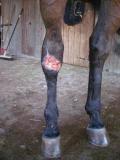
|
| Moderator: DrO |
Posted on Tuesday, Apr 22, 2008 - 6:17 am: Hello Cathy,these are some of the hardest wounds to heal and take the longest. The reason in the motion of the joint is a constant aggravation. In general your wound appears to be healing well with a well established granulation bed that has attached to the skin all the way around. Much improved over the earlier photos. Yes you would expect the wound alone to cause lameness and swelling will improve after this is healed. If this photo is right after the hosing I would like to see a bit more exudate removed. We have a description of cleaning wounds with water and topical treatments at, Diseases of Horses » Skin Diseases, Wounds, and Swellings » Wounds / Burns » Long Term Deep Wound Care. But I think your veterinarian's decision to not treat at all at this point is just fine, you should not put anything on this wound without your vet's approval. DrO |
| Member: amara |
Posted on Tuesday, Apr 22, 2008 - 2:59 pm: Hi Cathy,I certainly cant add anything to what Dr.O has said, but wanted to say that many many years ago i used to work with a horse that had an injury very similar to what you are describing, except that she almost completely severed the tendon. at the time the vet said if she doesnt lay down she stands a chance (why the owners didnt rig a sling i dont know)...but the mare got thru it, and while she did get soem pretty nasty proud flesh, the initial wound was the size of the one that your mare has and in the end was about 1/4 that size, and that mare went on to be completely sound and when i stopped working with her was jumping 3ft+ fences easily...i know that at the barn i was at (and i was a teenager at the time), she got way less care than your horse will, so am sure you will do the right thing and you horse will be fine! |
| Member: cathyb1 |
Posted on Sunday, May 11, 2008 - 4:23 am: Here are some pictures of my mare's leg, 7 weeks after the original injury. The wound is slowly getting smaller, and proud flesh seems not to be a problem - it is all flat with the surrounding skin, so that's good. Following my vet's advice (and I have a lot of faith in him), I have left it unbandaged, and I hose it every couple of days, cleaning it back to bare flesh. I am not putting anything on it. It was very hard not to put stuff on, but it seems to be working. What concerns me is the swelling around the injury. The joint was not involved in the injury, but there is a lot of inflammatory swelling around the actual wound. My vet thinks time will fix it; but the swelling makes her move her hock a bit stiffly, and not flex it fully, and I'm worried that, if she keeps moving like this, she will never be sound. Is there some way I could hasten the reduction of inflammation around the site? Would bandaging help, or disrupt the healing of the wound itself? Or should I just wait?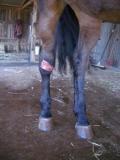 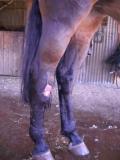 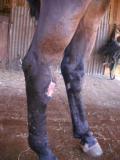 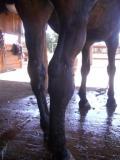
|
| Member: cathyb1 |
Posted on Sunday, May 11, 2008 - 4:26 am: You can see that there is a lot of swelling on the outside of the hock, and also immediately below the wound. It is not soft, but quite hard. There is also some filling in the lower leg, but she is a horse that swells up very easily, so I'm not too worried... should I be? |
| Moderator: DrO |
Posted on Sunday, May 11, 2008 - 9:56 am: The images are a bit small Cathy to make out any detail however as long as there is an open wound swelling is to be expected.DrO |
| Member: cathyb1 |
Posted on Friday, Dec 12, 2008 - 11:19 pm: Hi again, It is now some 9 months on from when my mare hurt herself. The wound has closed up to the point now where the open part is as big as an almond, and getting smaller, slowly, every day. For the last month, I have been just leaving the scabby tissue on it, which seems to allow the skin to move in better, and putting a bit of raw honey on the raw part of the wound to keep it moist. It is an ugly scar, with localised swelling; however, I noticed that the large amount of fibrous swelling around the hock started to decrease with walk exercise under saddle 6 months ago. Since then, she has been brought back into full work, and is working brilliantly - as sound as a bell! She has started canter pirouettes and sequence changes - a long way removed from the day when the vet who saw her said she might have to be put down, and if she survived, would never be a dressage horse again... so I am very, very lucky. One thing I have started with recently is a boot that contains LEDs that radiate infra red and ultraviolet waves, which is supposed to improve circulation and healing. Certainly, the swelling seems to be reducing every day, but it may be that it is just "time" for the leg to get better... so there you go, all you people with horses with horrific injuries, they DO get better! |
| Member: erika |
Posted on Saturday, Dec 13, 2008 - 10:04 pm: What a great update, Cathy. I can't believe how long you and your horse have been dealing with this injury! But you are obviously doing a great job.Thanks for the follow up. It is encouraging when someone gets a good result! Erika |
| Member: paul303 |
Posted on Saturday, Dec 13, 2008 - 10:50 pm: Well......Merry Christmas, one and all! |
| Moderator: DrO |
Posted on Sunday, Dec 14, 2008 - 9:40 am: Thank you so much for the update Cathy and considering the size of the initial injury the time frame is not excessive, maybe a bit longer than I would have expected. Personally I do not have much faith in the LED light boot but to the degree that it gently warms the leg it may help. Would it be possible to have a image of the leg so we can estimate the functionality of the scar tissue?DrO |
| Member: maggienm |
Posted on Sunday, Dec 14, 2008 - 9:56 am: Cathy, thank you for the update. As Erika said it will be a great comfort for someone else if they have an injury.I am so glad for you that your mare has regained good use of her hock. What a great lesson you related in your opening post. |
Horseadvice.com
is The Horseman's Advisor
Helping Thousands of Equestrians, Farriers, and Veterinarians Every Day
All rights reserved, © 1997 -
is The Horseman's Advisor
Helping Thousands of Equestrians, Farriers, and Veterinarians Every Day
All rights reserved, © 1997 -
